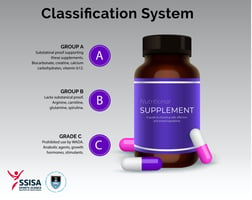Unlike medication, supplementation is poorly regulated in South Africa and internationally....
Nutritional Supplements and the Risk of Label Compliance
The foundation of sports performance is built on a well-designed diet and optimal training load. For many decades, novice sports people and athletes alike have been in search of optimal daily nutritional needs to best serve their performance (1–3). Due to various sports requiring a high energy load, nutritional supplementation is often used to combat deficiencies in one’s diet. The aggressively marketed nutritional supplement industry claims to have multiple effects in enhancing performance, with very little supporting evidence (1–3). Despite the lack of proof, the industry is estimated to be worth $66 billion by 2028 (4)

Unlike medication, supplementation is for the most part unregulated, resulting in all the risk falling on the consumer. A study conducted in South Africa on 30 different nutritional supplements found 60% of these them contained prohibited substances (3). One of the most common being Ephedrine. Ephedrine is a stimulant used on patients who are under anaesthetic to maintain a healthy blood pressure and can be used to enhance sporting performance (5). It is commonly labelled as Ma Huang and is missed by most consumers, under the roose it’s a natural tea extract (2). Regardless of the name, it has been banned by the World Anti-Doping Agency (WADA) since early 2000’s due to negative side effects and dependency. Despite supplement label claims, it is the consumer that is accountable for taking supplements that contain substances banned by WADA, and not the manufacturer for incorrect labelling (2). As an example, a Canadian bobsled athlete was banned for 20 months in 2008, based on a positive test, which was subsequently discovered to be an unlabelled ingredient in one of his supplements (2).
In an industry where compliance comes second to sales, the importance of trained professionals is of utmost importance. To avoid risk to sports people, dietary goals should be met under the supervision of a registered dietician, who has experience in sports performance and supplementation.
To bring you the most evidence-based and cutting information in the fields of sports and exercise science and health, SSISA works alongside the UCT Research Centre for Health through Physical Activity, Lifestyle and Sport (HPALS) to disseminate the latest research. HPALS research focuses on optimizing human performance and promoting health and well-being through physical activity, sports participation, healthy eating and good sleep hygiene. Their work begins at the DNA, to the human performance laboratory and ultimately to the community. To read more about the Health through Physical Activity, Lifestyle and Research Centre, Division of Physiological Sciences at the University of Cape Town, please see the HPALS website or email Ayesha Hendricks for more information about applications for MSc/PhD research programmes.
To get in touch with the Sports Science Institute of South Africa Group for Research Implementation and Translation (GRIT) Research Consultants, get in touch with Warren Lucas at research@ssisa.com or call 021 650 5728 for enquiries. Read more about the SSISA GRIT Team here.
Yours in Sports Science,
Sports Science Institute of South Africa
References:
- Bishop D. Dietary Supplements and Team-Sport Performance.
- Pipe A, Ayotte †christiane. Nutritional Supplements and Doping. Clin J Sport Med. 2002;12:245–9.
- van der Merwe P, Grobbelaar E. Inadvertent doping through nutritional supplements is a reality. Sports Medicine. 2004;16.
- Fernandes E. Sports Nutrition Market size worth $ 66 Billion, Globally, by 2028 at 7.9% CAGR: Verified Market Research. Cision PR Newswire. 2002.
- Persky AM, Berry NS, Pollack GM, Brouwer KLR. Modelling the cardiovascular effects of ephedrine. Br J Clin Pharmacol. 2004 May;57(5):552–62.


